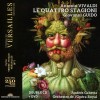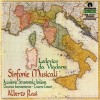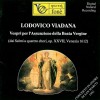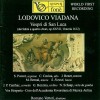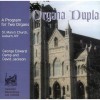Composers
Lodovico Grossi da Viadana (usually Lodovico Viadana, though his family name was Grossi; ca. 1560 – 2 May 1627) was an Italian composer, teacher, and Franciscan friar of the Order of Minor Observants. He was the first significant figure to make use of the newly developed technique of figured bass, one of the musical devices which was to define the end of the Renaissance and beginning of the Baroque eras in music.
He was born in Viadana, a town in the province of Mantua (Italy). According to a document dating from about 150 years after his death, he was a member of the Grossi family but took the name of his birth city, Viadana, when he entered the order of the Minor Observants prior to 1588 (Mompellio 2001). Though there is no contemporary evidence, it has been claimed that he studied with Costanzo Porta (Mompellio 2001), becoming choirmaster at the cathedral in Mantua by 1594. In 1597 he went to Rome, and in 1602 he became choirmaster at the cathedral of San Luca in Mantua. He held a succession of posts at various cathedrals in Italy, including Concordia (near Venice), and Fano, on the east coast of Italy, where he was maestro di cappella from 1610 to 1612 (Mompellio 2001). For three years, from 1614 to 1617, he held a position in his religious order which covered the entire province of Bologna (including Ferrara, Mantua and Piacenza). By 1623 he had moved to Busseto, and later he worked at the convent of Santa Andrea, in Gualtieri, near Parma. He died in Gualtieri (Mompellio 2001).
Viadana is important in the development of the early Baroque technique of basso continuo, and its notational method, known as figured bass. While he did not invent the method—figured basses occur in published sources from at least as early as 1597 (Williams and Ledbetter 2001)—he was the first to use it in a widely-distributed collection of sacred music (Cento concerti con il basso continuo), which he published in Venice in 1602. Agostino Agazzari in 1607 published a treatise describing how to interpret the new figured bass, though it is clear that many performers had by this time already learned the new method, at least in the most progressive musical centers in Italy.
Viadana composed mostly sacred music: masses, Psalms, magnificats, motets, and lamentations, though there are two books of secular canzonette and a book of eight-voice Sinfonia musicali. His earlier music is clearly in a Renaissance style, strictly a cappella with balanced polyphony between the voices, but after 1602 he wrote increasingly in an early Baroque style, with frequent concertato passages, and always with a basso continuo. He also used the monodic style, especially in his later works, and some of his Psalm settings (for example the Salmi op. 27, for four spatially separated choruses) are progressive works in the Venetian polychoral style. In addition, some of his later works anticipate the later instrumental concerto: they indicate specific instrumentation—still not a widely used practice—and they involve back-and-forth dialog between groups of voices and instruments.
He also wrote some secular music, but the quantity is limited as may be expected from a member of a strict religious order. These include two volumes of canzonettas (one for three, and one for four voices) and a volume of instrumental sinfonias, which are actually more like typical canzonas (terminology was loose in the decades right around 1600: what one composer called a sinfonia, another might call a fantasia, canzona, or a ricercar). In the sinfonias each individual composition bears the name of a different town in Italy: they can almost be conceived as an early kind of program music.
Viadana's music was influential not only in Italy, but also in Germany, on composers such as Michael Praetorius, Johann Hermann Schein and Heinrich Schütz. It was largely through Viadana that the concertato style arrived in Germany, the country that was to develop it most eagerly in the early 17th century.
Recently Added
| Country: | Italy |
| Period: | Renaissance, Baroque |
Biography
Lodovico Grossi da Viadana (usually Lodovico Viadana, though his family name was Grossi; ca. 1560 – 2 May 1627) was an Italian composer, teacher, and Franciscan friar of the Order of Minor Observants. He was the first significant figure to make use of the newly developed technique of figured bass, one of the musical devices which was to define the end of the Renaissance and beginning of the Baroque eras in music.
He was born in Viadana, a town in the province of Mantua (Italy). According to a document dating from about 150 years after his death, he was a member of the Grossi family but took the name of his birth city, Viadana, when he entered the order of the Minor Observants prior to 1588 (Mompellio 2001). Though there is no contemporary evidence, it has been claimed that he studied with Costanzo Porta (Mompellio 2001), becoming choirmaster at the cathedral in Mantua by 1594. In 1597 he went to Rome, and in 1602 he became choirmaster at the cathedral of San Luca in Mantua. He held a succession of posts at various cathedrals in Italy, including Concordia (near Venice), and Fano, on the east coast of Italy, where he was maestro di cappella from 1610 to 1612 (Mompellio 2001). For three years, from 1614 to 1617, he held a position in his religious order which covered the entire province of Bologna (including Ferrara, Mantua and Piacenza). By 1623 he had moved to Busseto, and later he worked at the convent of Santa Andrea, in Gualtieri, near Parma. He died in Gualtieri (Mompellio 2001).
Viadana is important in the development of the early Baroque technique of basso continuo, and its notational method, known as figured bass. While he did not invent the method—figured basses occur in published sources from at least as early as 1597 (Williams and Ledbetter 2001)—he was the first to use it in a widely-distributed collection of sacred music (Cento concerti con il basso continuo), which he published in Venice in 1602. Agostino Agazzari in 1607 published a treatise describing how to interpret the new figured bass, though it is clear that many performers had by this time already learned the new method, at least in the most progressive musical centers in Italy.
Viadana composed mostly sacred music: masses, Psalms, magnificats, motets, and lamentations, though there are two books of secular canzonette and a book of eight-voice Sinfonia musicali. His earlier music is clearly in a Renaissance style, strictly a cappella with balanced polyphony between the voices, but after 1602 he wrote increasingly in an early Baroque style, with frequent concertato passages, and always with a basso continuo. He also used the monodic style, especially in his later works, and some of his Psalm settings (for example the Salmi op. 27, for four spatially separated choruses) are progressive works in the Venetian polychoral style. In addition, some of his later works anticipate the later instrumental concerto: they indicate specific instrumentation—still not a widely used practice—and they involve back-and-forth dialog between groups of voices and instruments.
He also wrote some secular music, but the quantity is limited as may be expected from a member of a strict religious order. These include two volumes of canzonettas (one for three, and one for four voices) and a volume of instrumental sinfonias, which are actually more like typical canzonas (terminology was loose in the decades right around 1600: what one composer called a sinfonia, another might call a fantasia, canzona, or a ricercar). In the sinfonias each individual composition bears the name of a different town in Italy: they can almost be conceived as an early kind of program music.
Viadana's music was influential not only in Italy, but also in Germany, on composers such as Michael Praetorius, Johann Hermann Schein and Heinrich Schütz. It was largely through Viadana that the concertato style arrived in Germany, the country that was to develop it most eagerly in the early 17th century.

